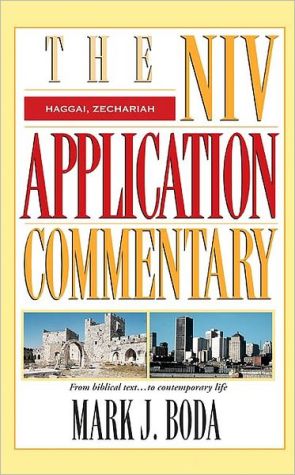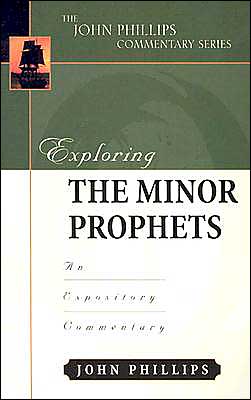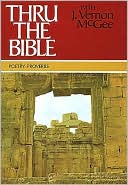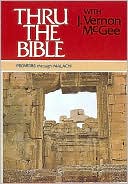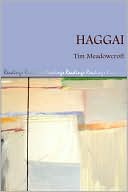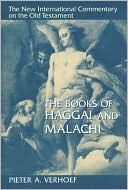Haggai, Zechariah
The NIV Application Commentary Series\ The setting: Jerusalem. Recently returned from Babylonian captivity, the Jews are occupied with personal pursuits while the temple of Yahweh lies in ruins. To the prophets Haggai and Zechariah falls the task of calling God's people to their forgotten priority: rebuilding his house. Heeding prophetic admonition, the people overcome the obstacles that face them and prosper in their work----thanks largely to the vision and encouragement of the prophets.\...
Search in google:
Haggai/Zechariah, which is part of the NIV Application Commentary Series, helps readers learn how the message of these two prophets who challenged and encouraged the people of God after the return from Babylon can have the same powerful impact on the community of faith today.
The NIV Application Commentary: Haggai, Zechariah Copyright © 2004 by Mark J. Boda\ Requests for information should be addressed to:\ Zondervan, Grand Rapids, Michigan 49530\ Library of Congress Cataloging-in-Publication Data Boda, Mark J. Haggai, Zechariah / Mark. J. Boda. p. cm.--(The NIV application commentary) Includes bibliographical references (p. ) and indexes. ISBN: 0-310-20615-4 (hardcover) 1. Bible. O.T. Haggai--Commentaries. 2. Bible. O.T. Zechariah--Commentaries. I. Title. II. Series. BS 1655.53.B63 2004 224'.97077--dc22 2004005204 CIP\ This edition printed on acid-free paper.\ All Scripture quotations, unless otherwise indicated, are taken from the Holy Bible: New International Version®. NIV®. Copyright © 1973, 1978, 1984 by International Bible Society. Used by permission of Zondervan. All rights reserved.\ The website addresses recommended throughout this book are offered as a resource to you. These websites are not intended in any way to be or imply an endorsement on the part of Zondervan, nor do we vouch for their content for the life of this book.\ All rights reserved. No part of this publication may be reproduced, stored in a retrieval system, or transmitted in any form or by any means--electronic, mechanical, photocopy, recording, or any other--except for brief quotations in printed reviews, without the prior permission of the publisher.\ Printed in the United States of America\ 04 05 06 07 08 09 /.DC/10 9 8 7 6 5 4 3 2 1\ We want to hear from you. Please send your comments about this book to us in care of zreview@zondervan.com. Thank you.\ Introduction to Haggai and Zechariah\ IN HIS 1956 BOOK Everyday Life in OldTestament Times, E. W. Heaton provides an artistic illustration of the exiles of Judah marching under armed Babylonian guard through the famous Ishtar gate of Babylon. Underneath the picture is the caption: "The Closing Scene of Old Testament Times: The Babylon of Nebuchadnezzar." This title captures the sentiments of many readers of the Old Testament, that after the destruction of Jerusalem the story of redemption fades into the haze of exile only to reappear with the birth of Christ in the New Testament. There is no question that most of the events of Israel that are fixed in the cultural consciousness of the church happened prior to the fall of Jerusalem in 587 B.C., such as the call of Abraham, the rise of Joseph, the exploits of Samson, the victories of David, or the proclamations of Elijah.\ The period in which Haggai and Zechariah lived and ministered, therefore, does not receive much attention in Christian circles. A preference for the earlier stories of Israel is apparent for several reasons. (1)With the fall of Jerusalem in 587 B.C. the Israelites did not regain independence from foreign powers until the Maccabean revolt. Even the province in which part of the Jewish remnant lived was a mere fraction of its size under David and Solomon. This does not make for great storytelling, although Daniel and Esther enjoy some popularity.\ (2) The New Testament accounts of Jesus and Paul portray the leadership of the Jews (the Sadducees, Pharisees, and teachers of the law) in a negative light. These various groups arose in the period between the Babylonian destruction of Jerusalem and the birth of Christ, and thus the literature from this period is read through the lens of the New Testament critique of these groups. Books like Ezra and Nehemiah are disparaged for their close attention to the law.\ (3) The rebuilding of the temple and the city of Jerusalem is seen as odd in light of Christ's coming. Why rebuild the temple only to have it rejected by Christ in his ministry?\ These factors introduce us to some of the major hurdles for preaching and teaching on Haggai and Zechariah. In order to appropriate the rich theology of these books for contemporary audiences, we need to overcome these challenges. The purpose of this introduction is to provide historical literary, biblical-theological, and contemporary orientation for the interpreter of Haggai and Zechariah. We will begin with a basic orientation to the history and literature of these books, ending with a summary of the basic theological message to their ancient audience (Original Meaning). Then we will offer a biblical-theological orientation so that Christian readers can appropriate the truth of Haggai and Zechariah for their lives today (Bridging Contexts). Finally, we will survey key implications of the theology of Haggai and Zechariah for church and society today (Contemporary Significance). In this way my desire is to strike a balance between history and theology, always sensitive to the fact that the theological truth of the Scriptures has been delivered within particular historical contexts through particular literary forms.\ ORIGINAL MEANING\ BECAUSE THE PREVAILING historical approach to the Scriptures in the modern era has often turned the Bible into a museum piece, theologians are increasingly abandoning historical context in their search for theological truth. This shift is challenged in Tom Wright's parody of the prodigal son, in which the prodigal is the historical study of the Bible. Wright attacks theologians who have taken "off their historical sandals lest they tread on holy ground" and reminds us that "stripped of its arrogance, its desire to make off with half of the patrimony and never be seen again, history belongs at the family table. If theology, the older brother, pretends not to need or notice him it will be a sign that he has forgotten, after all, who his father is." It will become evident throughout the commentary that I utilize a three-dimensional hermeneutic, one that seeks to interpret these texts in their ancient context (historical dimension) with sensitivity to their message encased in literary form (literary dimension), but also as texts with a relevant message appropriated by contemporary readers seeking to interpret and live faithfully as Christians (contemporary dimension). In this way my desire is to strike a balance between history and theology, always sensitive to the fact that the theological truth of the Scriptures has been delivered within particular historical contexts through particular literary forms\ A. History of the Early Persian Period\ NABONIDUS, ONE of the last emperors of Babylon, records a dream in which he receives instruction from the god Marduk to go to his mother's temple in Haran (which was under the control of the Medes) and rebuild it:\ "In the beginning of my everlasting reign he made me to see a vision. Marduk, the great lord, and Sin, the light of heaven and earth, stood on either side. Marduk said to me: "Nabonidus, King of Babylon, haul bricks with your wagon-horses, rebuild E-hul-hul, and make Sin, the great lord, to take up his residence therein." Reverently I spoke to the lord of the gods, Marduk: "The Medes have encompassed that house, which you did command to rebuild, and their forces are mighty." But Marduk said to me: "The Medes of whom you have spoken--they, their country, and the kings who marched with them are no more." On the approach of the third year they instigated Cyrus, King of Anzan, his petty vassal, to attack them, and with his few troops he routed the numerous Medes. He seized Astyages, King of the Medes, and took him as a captive to his own country. (It was) the word of the great lord, Marduk, and Sin, the light of heaven and earth, whose command can not be annulled".\ This dream assembles a fascinating trio of leaders who rose to prominence in the final phase of the Neo-Babylonian empire in mid-sixth century B.C.: Nabonidus of Babylon, Astyages of Media, and Cyrus of Persia. To set the stage for this dream and the impact of these characters on the Jewish community, we need to return to the beginning of the sixth century and the reign of an earlier Babylonian emperor, Nebuchadnezzar.\ Probably the ancient emperor most familiar to us is Nebuchadnezzar, ruler of the Neo-Babylonian empire from 605-562 B.C.6 His father, Nabopolassar (626-605), in concert with Cyaxares of Media (625-585), wrested control of the ancient Near East from the Assyrians during an extended struggle that
Contents9 Series Introduction13 General Editor's Preface15 Author's Preface17 Abbreviations21 Introduction to Haggai and Zechariah69 Outline of Haggai and Zechariah73 Bibliography on Haggai and Zechariah85 Text and Commentary on Haggai173 Text and Commentary on Zechariah541 Scripture Index566 Subject Index572 Author Index
